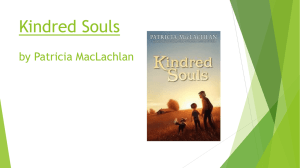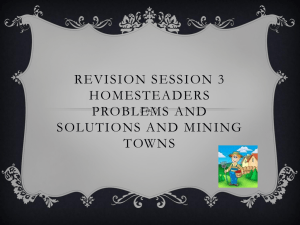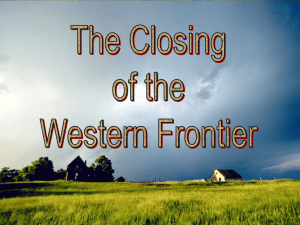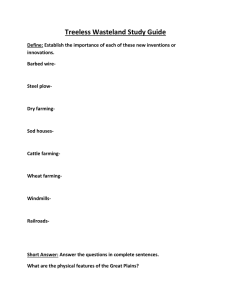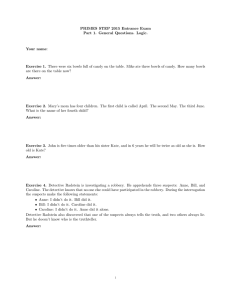Understanding Sudden Oak Death: A Model of Partnership and Collaboration Key words:
advertisement
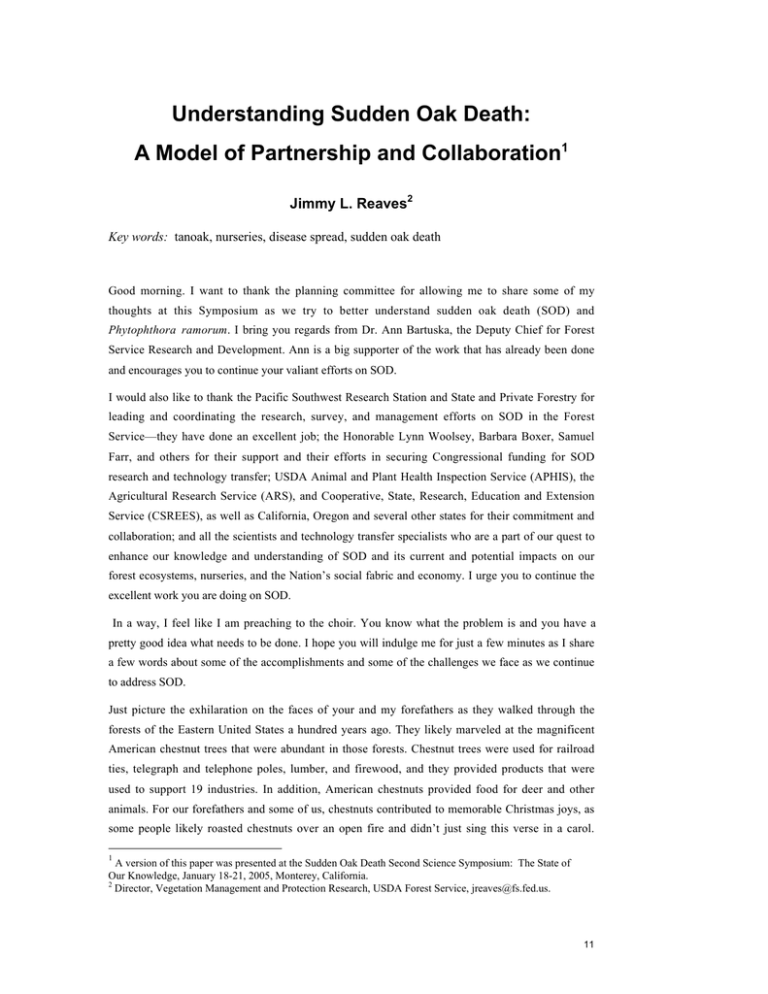
Understanding Sudden Oak Death: A Model of Partnership and Collaboration1 Jimmy L. Reaves2 Key words: tanoak, nurseries, disease spread, sudden oak death Good morning. I want to thank the planning committee for allowing me to share some of my thoughts at this Symposium as we try to better understand sudden oak death (SOD) and Phytophthora ramorum. I bring you regards from Dr. Ann Bartuska, the Deputy Chief for Forest Service Research and Development. Ann is a big supporter of the work that has already been done and encourages you to continue your valiant efforts on SOD. I would also like to thank the Pacific Southwest Research Station and State and Private Forestry for leading and coordinating the research, survey, and management efforts on SOD in the Forest Service—they have done an excellent job; the Honorable Lynn Woolsey, Barbara Boxer, Samuel Farr, and others for their support and their efforts in securing Congressional funding for SOD research and technology transfer; USDA Animal and Plant Health Inspection Service (APHIS), the Agricultural Research Service (ARS), and Cooperative, State, Research, Education and Extension Service (CSREES), as well as California, Oregon and several other states for their commitment and collaboration; and all the scientists and technology transfer specialists who are a part of our quest to enhance our knowledge and understanding of SOD and its current and potential impacts on our forest ecosystems, nurseries, and the Nation’s social fabric and economy. I urge you to continue the excellent work you are doing on SOD. In a way, I feel like I am preaching to the choir. You know what the problem is and you have a pretty good idea what needs to be done. I hope you will indulge me for just a few minutes as I share a few words about some of the accomplishments and some of the challenges we face as we continue to address SOD. Just picture the exhilaration on the faces of your and my forefathers as they walked through the forests of the Eastern United States a hundred years ago. They likely marveled at the magnificent American chestnut trees that were abundant in those forests. Chestnut trees were used for railroad ties, telegraph and telephone poles, lumber, and firewood, and they provided products that were used to support 19 industries. In addition, American chestnuts provided food for deer and other animals. For our forefathers and some of us, chestnuts contributed to memorable Christmas joys, as some people likely roasted chestnuts over an open fire and didn’t just sing this verse in a carol. 1 A version of this paper was presented at the Sudden Oak Death Second Science Symposium: The State of Our Knowledge, January 18-21, 2005, Monterey, California. 2 Director, Vegetation Management and Protection Research, USDA Forest Service, jreaves@fs.fed.us. 11 GENERAL TECHNICAL REPORT PSW-GTR-196 Along with having economic value and contributing to ecosystem integrity, I am convinced that the connection made to these magnificent wonders of nature left an indelible mark on the lives of our forefathers. Our forefathers and others living at the turn of the 20th century believed that American chestnuts and other trees would always be plentiful—the phrase “the land of plenty” was real to them. They could not know that within the next century there would not be any real chestnut trees left to support industries or to stir our spiritual awareness. Root rot caused by the pathogen Phytophthora cinnamomi, and, to a larger extent, chestnut blight caused by the pathogen Cryphonectria parasitica, did what loggers, windstorms, hurricanes, tornados, floods, and fire could not do—wipe out the beloved American chestnut trees in this country. We are now faced with what our ancestors were faced with at the turn of the 20th century. Phytophthora ramorum, the pathogen that causes SOD, has appeared on the scene and has the potential to wipe out not just one species of oak, but several species, and not just in the western part of the country but in other parts of the country and elsewhere in the world. In addition, SOD has caused major losses already to a number of California nurseries, and has the potential to adversely impact our Nation’s entire nursery industry, resulting in millions of dollars in losses each year. Just imagine the impact that would have on wood and paper industries in this country, wildlife habitat and forest ecosystems, hunting, recreation, and the spiritual values of oak trees that are near and dear to us. At the turn of the 20th century, scientists were able to isolate and identify fairly early the fungus that was responsible for chestnut blight, but they did not have the scientific knowledge or the technology to develop and institute effective control measures to combat the spread of that disease. Today we are fortunate because we do have the scientific capability to develop and institute management and control measures to combat the spread and destruction caused by P. ramorum. We know something about the biology of this organism and have some idea how it spreads. As I speak, we are developing better ways to manage it. We have to be vigilant in our efforts to keep SOD and P. ramorum from spreading beyond current boundaries. Our collective knowledge, coupled with collaborative efforts across Federal, State and international governmental agencies, is strengthened by university partnerships, the efforts of private industry, and community involvement. Our collective efforts position us well to conduct innovative research and institute management practices and appropriate policy measures to combat the spread of SOD. Since we don’t fully understand the biology of this organism or the dynamics of the various diseases that it causes, we still have much to learn. Let’s take a look at what we currently know about the organism. P. ramorum was discovered in 2000. This virulent pathogen of unknown origin has spread to forests in 14 coastal California counties, as well Oregon’s Curry County. It has also been found in numerous European nurseries and gardens, and most recently in nurseries in Washington, Oregon, and British Columbia, Canada. 12 Proceedings of the sudden oak death second science symposium: the state of our knowledge This past year, shipments from the West Coast sent plants from infested nurseries to several more States, triggering extensive survey and management efforts, as well as new regulations. The pathogen has a broad host range, including: o hardwood trees, such as coast live oak o landscape plants, such as rhododendron o herbaceous plants, such as western starflower o softwood trees, such as coast redwood and Douglas-fir P. ramorum has already killed tens of thousands of coast live oak, tanoak, and California black oak trees. The pathogen causes branch and twig dieback in conifers and several shrubs, as well as leaf blight in mountain laurel, camelia, and other species. In California, P. ramorum negatively affects ecosystem functions, increases fire and safety hazards, and reduces property values in developed areas. I realize that this is not an exhaustive list. Research results to be presented at this Symposium will fill in a few more pieces of the SOD puzzle. As you can see, we have a formidable foe on our hands. It is going to take substantial funding, well-coordinated research and technology transfer, and sound policy decisions to effectively combat the spread of this pathogen and markedly reduce its impacts. I have painted a rather dismal picture of the potential results that could occur from the spread of SOD. I do not want the picture I have painted to become a self-filling prophecy. However, if we don’t generate the science to understand the disease and deliver this science in a usable form to our public and private land managers, what happened to our beloved American chestnuts could easily be repeated. Remember, it took more than 80 years to start to bring back the American chestnut. If we are not vigilant in our efforts against SOD, we may be faced with a similar scenario that was caused by chestnut blight and other invasive species. Now having laid out a bleak picture on the potential adverse impacts that could result from SOD, what are some of the positives that we have in our favor? Unlike our forefathers, we do know the pathogen responsible for SOD, at what I believe is an early stage. We have some idea as to how it spreads; we know a number of its hosts; and we know how to kill it on some substrates. We have some funding thanks to the Honorable Barbara Boxer, Lynn Woolsey, and others, and I would like to thank them again for their strong support. And we have Federal, State, and local political support to study the disease, with the end goal of being able to eventually control it. We have a capable cadre of scientists to provide the necessary knowledge about the disease. We have technology transfer agents in place, and the expertise to effectively deliver information to needy users. Our efforts to understand SOD are being refined through a SOD program review led by Forest Service Research and Development. I believe that the Pacific Southwest Research Station has done an excellent job of spearheading our SOD research program to date. Determining if there are ways we might improve on this effort will be the focus of a review team. The team first met face-to-face yesterday at the Symposium. The results of this review will be shared with everyone when completed by Forest Service Research and Development, through collaboration with Forest Service 13 GENERAL TECHNICAL REPORT PSW-GTR-196 State and Private Forestry, ARS, CSREES, and APHIS. Also, a SOD national strategic plan that was called for by Congress has been completed through collaboration among the Forest Service, ARS, CSREES, and APHIS. Even though we have marshaled our resources in an effective and timely manner, we still face considerable challenges as we address current and emerging SOD issues. Allow me to outline what I believe are some of these challenges and possible solutions. 1) Maintaining collaboration across organizational lines to address the science and management issues surrounding SOD Proposed solution (s): We need to: (a) organize strategic alliances across organizational boundaries; (b) cooperate as a multi-faceted team as we develop and implement research programs to study SOD; (c) focus our efforts on the highest priority needs; and (d) keep all communication doors open. 2) Maintaining a long-term research effort on SOD Proposed solution(s): We need to continue to maximize the efforts of scientists in all countries and agencies involved. Include research problems in appropriate planning documents such as research work unit descriptions or problem analyses. Such efforts will then allow us to: (a) develop a better understanding of the pathogen and its dynamics; (b) get a better handle on the host range of the pathogen; (c) explore the dynamics of the disease and the importance of climatic conditions to disease development; (d) better understand potential cascading ecological effects, as well as social and economic impacts; and (e) hopefully confirm the origins of the pathogen. By knowing the pathogen’s origin, we will have a better chance of identifying its natural biological enemies that could possibly be used in management practices. I believe there are some efforts underway to do just that. 3) Securing consistent and long-term funding for SOD Proposed solution(s): Continue to seek funding from Congress through the budget process and find ways to leverage the dollars we are able to secure. Seek funding through granting agencies outside of the Federal budget process. We need to maximize our resources to improve outcomes and address priorities. 4) Delivering usable science to public and private landowners Proposed solution(s): The public can play an integral part in our success in combating the spread of SOD. In order for that to occur, however, we must provide the public with the necessary information in ways and in a format that they can understand, not in “sciencespeak.” There are some excellent examples out there where this has occurred. In one instance, the Fish and Wildlife Service is using trained volunteers to help with early detection, targeting invasive species at six refuges where they conduct approximately 20 percent of all work on the refuges. We could benefit from similar programs. 5) Developing sound policies that take into consideration the economic aspects of SOD 14 Proceedings of the sudden oak death second science symposium: the state of our knowledge Proposed solution(s): We must work across organizational boundaries and provide the necessary scientific knowledge and leadership to help agencies like APHIS develop sound regulatory policies for SOD. Please understand that what I have outlined is in no way meant to be construed as an exhaustive list, but rather as an inward look at some the challenges and possible solutions. As this is a scientific forum, I am sure that at least some of you may not agree with what I have presented. That’s fine—it’s healthy for the necessary debate. I believe that healthy debates lead to sound solutions. I do know that we must continue to be vigilant in our efforts against SOD. In closing, I would like to take a phrase from one of my favorite philosophers, the sometimes gregarious Yogi Berra, the Hall of Fame catcher for the New York Yankees. Yogi once said, “You’ve got to be careful if you don’t know where you are going, ‘cause you might not get there.” I feel strongly that we know where we are going. With your leadership, I am confident that we will get there. 15
